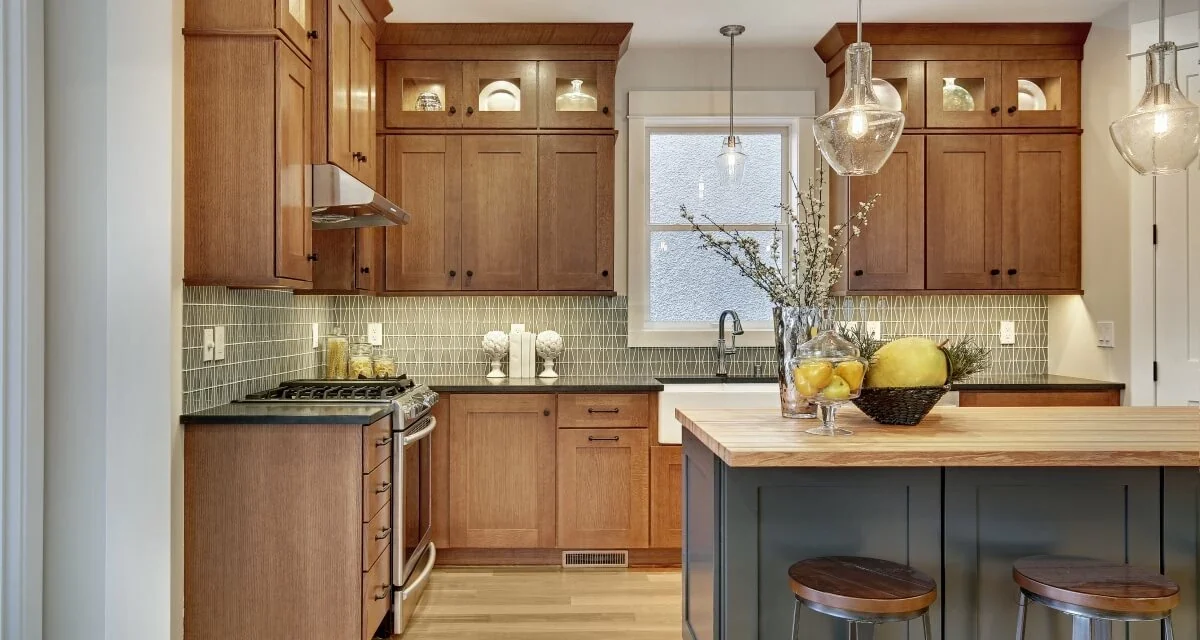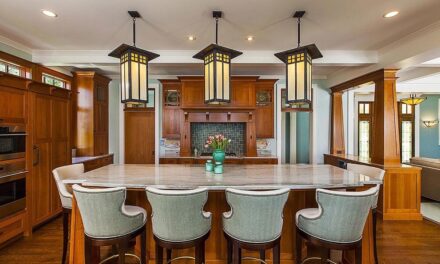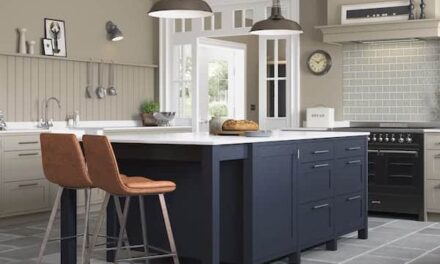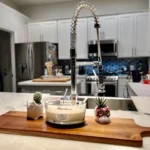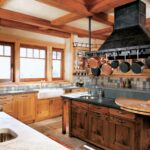Welcome to a kitchen that embodies the timeless charm of craftsman style home kitchen, where craftsmanship and functionality converge in a harmonious blend. This kitchen, inspired by the rich tradition of early 20th-century design, is a celebration of artistry and practical elegance. Imagine stepping into a space where every detail tells a story: from the warm, natural wood cabinetry with its hand-carved details to the intricate tile work that echoes the geometric patterns of classic Craftsman design.
The Craftsman kitchen is more than just a place to cook; it’s a testament to the enduring beauty of handcrafted elements and thoughtful design. The use of exposed wooden beams and built-in features reflects a commitment to quality and a reverence for the simple, yet sophisticated aesthetic of the era. With its blend of rich mahogany tones, earth-inspired hues, and artisanal finishes, this kitchen invites you to experience the comfort and authenticity of a bygone era. It’s a space where modern convenience meets timeless elegance, creating a welcoming environment that feels both cozy and distinguished. Here, every meal is not just prepared but celebrated amidst a backdrop of unparalleled craftsmanship.
Timeless Charm: Crafting the Perfect Craftsman Style home Kitchen
Here’s a detailed guide on how to craft the perfect Craftsman-style kitchen that embodies timeless charm and functionality.For more information visit here
Table of Contents
Understanding the Craftsman Style
Origins and Aesthetic: The craftsman style home kitchen emerged as a reaction against the industrialization of the late 19th and early 20th centuries. It celebrates handcraftsmanship, natural materials, and the beauty of simplicity. Key features include:
- Exposed Woodwork: Beams, wainscoting, and cabinetry often highlight the natural beauty of wood.
- Built-In Furniture: Features like benches, bookcases, and storage units are integrated into the room’s design.
- Handcrafted Details: Attention to detail with hand-carved elements, joinery, and artisan touches.
Color Palette: Craftsman kitchens typically feature earthy tones inspired by nature. Think warm browns, deep greens, rich blues, and muted oranges. These colors complement the natural woodwork and create a cozy, inviting atmosphere.
Design Elements of a Craftsman Kitchen
Cabinetry: Cabinets in a craftsman style home kitchen are often made from high-quality wood such as oak, maple, or cherry. They usually feature:
- Simple, Straight Lines: Avoid ornate designs. Instead, opt for clean, rectilinear shapes.
- Flat Panel Doors: These are a hallmark of the Craftsman style, offering a simple and elegant look.
- Handcrafted Hardware: Look for bronze or iron knobs and pulls that reflect traditional craftsmanship.
Countertops: While granite and quartz are popular modern choices, for a true Craftsman feel, consider:
- Butcher Block: Adds warmth and is practical for food preparation.
- Soapstone: Offers a rustic look and is known for its durability.
- Tile: Handmade ceramic or encaustic tiles can add a touch of artistry to the space.
Backsplash: A Craftsman-style backsplash often features:
- Handmade Tiles: Opt for tiles with intricate patterns or textures that reflect the artisanal quality of the era.
- Subway Tiles: A classic choice, especially in earthy tones or muted colors.
Floors: Wooden floors are ideal for a craftsman style home kitchen. Choose:
- Solid Hardwood: Oak or maple flooring with a natural finish enhances the authenticity of the style.
- Tile: If you prefer a more practical option, look for tiles that mimic the look of natural stone.
Architectural Features
Beams and Moldings: Exposed wooden beams and decorative moldings are quintessential craftsman style home kitchen elements. They can be:
- Ceiling Beams: Large, exposed beams can add architectural interest and emphasize the room’s height.
- Wainscoting: Wooden paneling that reaches partway up the wall adds character and warmth.
Built-Ins: Built-in furniture and fixtures are a hallmark of Craftsman design. Consider:
- Bench Seating: A built-in bench with storage can be a charming addition to the craftsman style home kitchen, perfect for a cozy breakfast nook.
- Open Shelving: Displaying dishes and kitchen essentials on open shelves can add both functionality and visual interest.
Windows: Craftsman windows are often characterized by:
- Grid Patterns: Multi-pane windows with divided sections are typical of the style.
- Wood Frames: Opt for wooden window frames to complement the rest of the kitchen design.
4. Fixtures and Hardware
Lighting: Lighting in a craftsman style home kitchen should be both functional and aesthetically pleasing. Look for:
- Pendant Lights: Choose fixtures with bronze or copper finishes and stained glass shades for a period-appropriate touch.
- Recessed Lighting: While modern, it should be unobtrusive and blend seamlessly with the design.
Plumbing Fixtures: Craftsman kitchens often feature:
- Farmhouse Sinks: Also known as apron-front sinks, these offer a practical and stylish solution.
- Vintage Faucets: Look for faucets with classic detailing and finishes like oil-rubbed bronze or brushed nickel.
Hardware: Cabinet and drawer hardware should be:
- Handcrafted: Opt for hardware that features intricate details and a solid feel.
- Bronze or Iron: These materials add to the rustic, handcrafted vibe of the kitchen.
Incorporating Modern Amenities
While maintaining the craftsman style home kitchen, it’s important to integrate modern conveniences seamlessly:
- Appliances: Choose appliances that blend with the kitchen’s aesthetic. Panel-ready appliances that can be hidden behind cabinetry are ideal.
- Storage Solutions: Incorporate modern storage solutions such as pull-out shelves and lazy Susans, but ensure they are discreetly integrated.
Further Insights into Designing Your Craftsman-Style Kitchen
Space Planning and Layout
Optimal Layout: A craftsman style home kitchen should be designed with both aesthetics and efficiency in mind. Consider the following layouts:
- Galley Layout: This efficient design features parallel countertops and is ideal for smaller spaces. It promotes a streamlined workflow while allowing for built-in features.
- L-Shaped Layout: This versatile design provides ample counter space and room for built-in storage and appliances. It’s perfect for open-plan homes where the craftsman style home kitchen needs to blend seamlessly with adjacent areas.
- U-Shaped Layout: Offering three walls of cabinetry and counter space, this layout is great for larger kitchens. It provides plenty of storage and workspace while allowing for an open, inviting feel.
Traffic Flow: Ensure there is a clear path for movement and that key areas (sink, stove, refrigerator) are easily accessible. Consider the “work triangle” concept, which places these three main areas in a triangular layout to optimize workflow.
Zoning: Designate specific zones for cooking, prep, and cleaning. For example:
- Cooking Zone: Place the stove and oven here, along with pots, pans, and utensils.
- Prep Zone: Include ample counter space and storage for knives, cutting boards, and mixing bowls.
- Cleaning Zone: Position the sink and dishwasher for easy cleanup, and include storage for dishware and cleaning supplies.
Integrating Sustainability
Eco-Friendly Materials: Incorporate sustainable materials to align with the Craftsman ethos of craftsmanship and care for the environment:
- Reclaimed Wood: Using reclaimed wood for cabinetry or flooring adds character and reduces environmental impact.
- Bamboo: A rapidly renewable resource, bamboo can be used for cabinetry, countertops, and flooring.
- Low-VOC Paints: Opt for paints with low volatile organic compounds to ensure better indoor air quality.
Energy-Efficient Appliances: Select appliances that are energy-efficient and have high Energy Star ratings. This choice not only conserves energy but also aligns with the craftsman style home kitchen principle of functional, sustainable design.
Water Conservation: Install fixtures and appliances designed to conserve water, such as low-flow faucets and dual-flush toilets. Consider a water filtration system for improved water quality.
Customizing Your Craftsman Kitchen
Personalizing the Space: While adhering to the craftsman style home kitchen, make the kitchen uniquely yours by:
- Custom Cabinetry: Work with a carpenter to create bespoke cabinets that fit your exact needs and preferences. Custom features like built-in spice racks or drawer dividers can enhance functionality.
- Unique Details: Incorporate personal touches such as custom-built range hoods or decorative tile patterns that reflect your style.
Furniture: Choose or design furniture that complements the Craftsman aesthetic:
- Dining Table: Opt for a sturdy, handcrafted wooden table with classic detailing.
- Chairs: Look for chairs with simple lines and comfortable upholstery in natural fabrics.
Accessories: Accessorize your kitchen with items that enhance its charm:
- Rugs and Mats: Choose rugs with traditional patterns or simple, natural fiber mats.
- Cookware: Display quality, vintage-style cookware and utensils to add to the craftsman style home kitchen character.

Balancing Tradition with Modern Needs
Technology Integration: Incorporate modern technology in a way that doesn’t detract from the Craftsman style:
- Smart Appliances: Select smart appliances that blend with the kitchen’s aesthetic, such as built-in refrigerators with paneling to match cabinetry.
- Hidden Technology: Use cabinetry to hide modern tech like charging stations or built-in speakers, maintaining the room’s traditional look.
Comfort and Ergonomics: Ensure that while you honor traditional design, the craftsman style home kitchen remains comfortable and functional:
- Adjustable Shelving: Incorporate adjustable shelving to accommodate various needs and preferences.
- Ergonomic Design: Consider the ergonomics of kitchen workspaces to make cooking and cleaning more comfortable.
Additional Considerations for Your Craftsman-Style Kitchen
Enhancing Natural Light
Maximizing Light: craftsman style home kitchen benefit greatly from natural light, which complements their warm, natural materials. To enhance natural light:
- Windows: Opt for larger windows or add additional windows if possible. Craftsman windows often feature divided panes that allow more light while adding character.
- Skylights: If feasible, install skylights to bring in more natural light from above.
- Glass Doors: Consider incorporating glass-paneled doors in cabinets or pantry areas to allow light to flow through the space.
Lighting Fixtures: Enhance natural light with carefully chosen fixtures:
- Mission-Style Fixtures: Look for lighting fixtures with mission-style designs that feature stained glass, bronze, or copper finishes.
- Ambient Lighting: Use fixtures that provide diffuse, warm lighting to complement natural light and create a cozy atmosphere.
- Task Lighting: Incorporate under-cabinet lighting to illuminate work areas and ensure functionality.
Creating a Seamless Transition with Adjacent Spaces
Open Floor Plan: In open-plan homes, ensure that the craftsman style home kitchen integrates seamlessly with adjacent living or dining areas:
- Consistent Design Elements: Use similar materials, colors, and design elements to create visual harmony between the kitchen and adjoining spaces.
- Architectural Flow: Maintain architectural continuity by incorporating features like built-in shelving or matching trim that ties the kitchen to the rest of the home.
Transition Zones: Create smooth transitions between the kitchen and other areas:
- Flooring: Use the same or complementary flooring materials throughout the adjacent spaces to unify the design.
- Color Schemes: Extend the kitchen’s color palette into adjoining rooms for a cohesive look.
Addressing Practical Needs
Ventilation: Good ventilation is crucial for a functional kitchen:
- Range Hoods: Install a range hood that matches the craftsman style home kitchen, either in a wood finish or with traditional metal detailing.
- Ventilation Fans: Ensure that ventilation fans are powerful enough to handle cooking fumes and odors.
Storage Solutions: Effective storage solutions are essential for maintaining an organized kitchen:
- Pantry: Incorporate a walk-in or built-in pantry for additional storage space.
- Drawer Organizers: Use custom drawer organizers to keep utensils, cutlery, and kitchen tools neatly arranged.
- Cabinet Accessories: Add pull-out shelves, lazy Susans, and vertical dividers to maximize cabinet space.
Counter Space: Adequate counter space is crucial for functionality:
- Island: Consider adding a craftsman style home kitchen island with additional storage and counter space. It can also serve as a casual dining area.
- Extended Counters: Extend countertops where possible to provide more prep space.
Maintenance and Longevity
Durability of Materials: Choose materials that are durable and easy to maintain:
- Wood Finishes: Opt for high-quality wood finishes that can withstand daily use and are easy to clean.
- Countertop Materials: Select countertop materials that are resistant to stains, scratches, and heat.
Regular Upkeep: Establish a maintenance routine to keep the craftsman style home kitchen looking its best:
- Wood Care: Regularly dust and polish wooden surfaces to maintain their luster.
- Tile and Grout: Clean tiles and grout regularly to prevent build-up and discoloration.
- Fixtures: Check and clean fixtures periodically to ensure they remain in good working condition.
Navigating Challenges
Budget Considerations: craftsman style home kitchen can be an investment. To manage costs:
- Prioritize: Focus on key elements that define the Craftsman style, such as cabinetry and woodwork, while considering more budget-friendly options for other features.
- DIY Options: Consider DIY projects for smaller details, like painting or installing trim, to save on labor costs.
Space Limitations: In smaller kitchens, you can still achieve a Craftsman look by:
- Compact Design: Opt for space-saving designs that maximize functionality without compromising style.
- Multi-Functional Furniture: Use furniture that serves multiple purposes, such as a bench with built-in storage.
Historic Homes: If renovating a historic home, ensure that updates respect the original architectural features:
- Restoration: Work with professionals experienced in historic renovations to preserve and restore original elements while incorporating modern updates.
- Authentic Materials: Source materials that match or complement the original craftsmanship of the home.
Seeking Professional Guidance
Hiring Experts: For a successful craftsman style home kitchen renovation, consider hiring professionals:
- Interior Designers: Work with designers who have experience with Craftsman style to ensure your vision is realized.
- Carpenters and Craftsmen: Skilled craftsmen can create custom cabinetry and woodwork that reflects the authenticity of the style.
- Contractors: Choose contractors who have a track record of working on similar style projects and can manage the renovation efficiently.
Collaboration: Collaborate closely with your design and renovation team to:
- Define Your Vision: Clearly communicate your design goals and preferences.
- Review Plans: Regularly review design plans and progress to ensure alignment with your vision.
Additional Design Considerations and Inspiration
Crafting Custom Solutions
Tailoring Cabinetry: Custom cabinetry is a hallmark of the craftsman style home kitchen. To achieve a bespoke look:
- Custom Designs: Work with a carpenter to design cabinets that fit your space precisely, incorporating features like adjustable shelves, built-in spice racks, and custom drawers.
- Artisanal Details: Include handcrafted elements like dovetail joints, decorative carvings, or inlaid panels to enhance the artisanal feel.
Unique Fixtures: Custom fixtures can further enhance the kitchen’s authenticity:
- Handcrafted Range Hoods: Commission a range hood with a custom design, such as a wooden or metal hood with intricate detailing.
- Tailored Lighting: Design lighting fixtures that reflect Craftsman aesthetics, such as bespoke stained glass pendants or lantern-style sconces.
Blending Old and New
Modern Technology with Traditional Design: Integrate modern technology in a way that complements the craftsman style home kitchen:
- Smart Technology: Select smart appliances that can be seamlessly integrated with cabinetry, or hide tech features behind custom panels.
- Hidden Outlets: Install electrical outlets and charging stations in discreet locations to maintain the kitchen’s clean lines.
Contrasting Elements: Add contrast to the traditional Craftsman elements with modern touches:
- Mixed Materials: Combine traditional woodwork with modern materials like stainless steel or glass to create a balanced look.
- Contemporary Art: Incorporate contemporary art or accessories to add a modern twist without overwhelming the traditional design.
Exploring Historical and Regional Variations
Regional Influences: craftsman style home kitchen varies by region, reflecting local materials and styles:
- California Craftsman: Emphasizes natural materials like redwood and features open floor plans with extensive built-in furniture.
- Mission Revival: Focuses on stucco exteriors and Spanish tile, integrating ornate detailing and decorative elements.
- Shingle Style: Includes shingle siding and expansive porches, with an emphasis on informal, cozy interiors.
Historical Inspiration: Draw inspiration from historical Craftsman kitchens to ensure authenticity:
- Early 20th Century: Refer to original designs from the early 1900s for authentic detailing and layout.
- Historic Homes: If renovating a historic home, research period-specific details to maintain historical accuracy.
To sum up
Creating a kitchen in the craftsman style home kitchen involves combining original architectural elements with contemporary features. A kitchen that is both elegant and functional can be made by emphasising fine craftsmanship, organic materials, and creative solutions. Custom cabinetry, cutting-edge technology, and environmentally friendly design principles can make your Craftsman kitchen a treasured aspect of your house for many years to come, whether you’re renovating an old house or creating a brand-new one. Your kitchen will be a tribute to practicality and lasting beauty if you embrace the classic elegance of the Craftsman style while accommodating modern demands.

